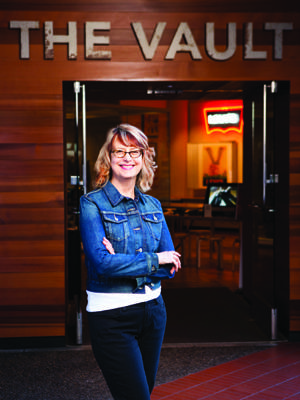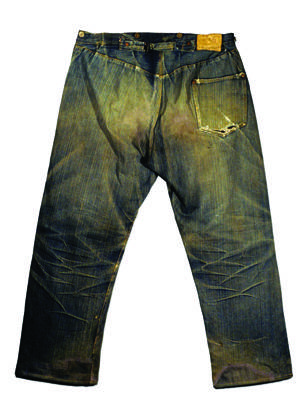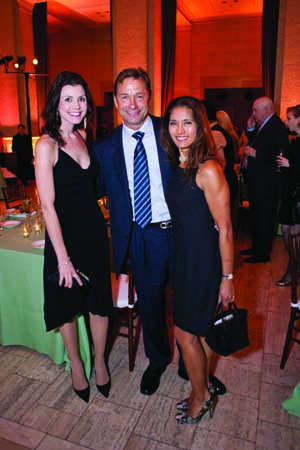Lynn Downey knows a well-worn pair of jeans when she sees one.
On display in Levi’s recently opened museum, The Vault, is the oldest pair of Levi’s 501 jeans, a garment dating back to 1879—and worth a staggering $150,000. It’s artifacts like these that Downey, Levi’s in-house curator, is responsible for in her newly appointed post as curator of The Vault, a museum that houses 150 years worth of vintage apparel and ephemera.
The Vault, located in the Levi Strauss Headquarters in San Francisco, showcases Levi’s fashion evolution and its intersection with culture from its inception. As quirky and fun-spirited as the city of San Francisco itself, The Vault houses all things Levi’s–rivets, vintage buttons, historic photographs, notable billboards and of course, jeans.
To many, to own a piece of Levi’s denim is to own a piece of history, and rightfully so.
The Vault is also home to iconic clothing from some of Hollywood’s biggest stars. One of the most captivating features of The Vault is a conveyer-belt display set inside a viewing window, showcasing Levi’s Trucker Jackets designed by celebrities and winners of Levi’s design contests. Jackets designed for celebrities including Elton John, Queen Latifah, Elizabeth Taylor, Michael Jackson and Lady Gaga are also on display.
Personally committed to preserving the past, Downey is very much in tune with the brand’s significance in the city, including the brand’s historic connection to San Francisco.
“Levi Strauss was a Bavarian immigrant and dry goods distributor and wholesaler who came to San Francisco in 1853,” Downey said. “In the early 1870s, a Reno, Nev. tailor named Jacob Davis was making men’s pants reinforced with metal rivets and needed a business partner to manufacture and market the new pants. So he and Levi Strauss got together and received a U.S. patent on the process of making men’s denim work pants with copper rivets. Men had worn denim pants as workwear for decades, but when [Levi’s] made the first riveted denim pants, that was the beginning of the blue jean.” And thus, perhaps the most enduringly popular item in fashion’s history was created.
While jeans’ popularity hasn’t waned, their role in a wardrobe certainly has, according to Downey.
“People today expect more from jeans,” she said. “They expect jeans to fill a much larger role in their wardrobe. In the beginning, jeans had one function only.” That was, to say, the function of appropriate, durable workwear for the working people of San Francisco.
To many, to own a piece of Levi’s denim is to own a piece of history, and rightfully so. The evolution of the brand is seamlessly woven into the history of its city of origin. For one, the history of Levi’s is very much entwined with the Gold Rush that swept the West Coast in the 19th century. What’s more, the formulation of such an iconic brand speaks to the entrepreneurial nature of the San Francisco Bay Area. While today, that sector is dominated by venture capital and technologically-based pursuits, back then, it was the Gold Rush business, World War II ship building, the movement for gay rights and the like.
“The company is one of the few remaining Gold Rush businesses to still survive in San Francisco,” Downey said. “We’ve done that by being committed to the kind of open and free-thinking lifestyle that the city represents. We’ve been a part of the major movements that got their start here: early entrepreneurship in the Gold Rush, World War II ship building, the movement for gay rights. All of these movements personify who we are as a company and a brand.”
Today, the $1.2 billion brand doesn’t just make jeans—it is synonymous with them.
Levi Strauss has swept the globe to reach households in more than 110 countries. With sub-brands that include Signature by Levi Strauss & Co., Dockers, Denizen and Levi’s environmentally conscious brand, Levi’s Capital E, the denim giant has become a ubiquitous classic.
Through the years, the American classic has been embraced by all walks of life, putting its clothes on everyone from office dwellers to entertainers to icons of many generations. In the 1950s, rebellious icons like James Dean and Marlon Brando made fashion statements with Levi’s 501 jeans and Levi’s classic denim trucker jackets. Today, actors like Johnny Depp, Brad Pitt, George Clooney, Drew Barrymore and Demi Moore are among many A-list fans of the brand. President Obama wears Levi’s 501 jeans in his downtime, while the late Steve Jobs was famous for his regular uniform of Levi’s 501 jeans paired a black turtleneck. The Silicon Valley has unabashedly adopted Dockers, setting the pace for the Bay Area’s casual office culture.
But the brand’s significance to San Francisco’s history runs deeper than fashion-related history. A ship dating back to the 19th century is buried underground at the company headquarters. Downey, ever the historian, recounts the story.
“During the Gold Rush, crazed gold-seekers would jump off the ships that came into San Francisco’s harbor,” she said. “Enterprising men from the city hauled the ships onto shore, converting them into warehouses, saloons, even a jail. As the ships rotted, they eventually became part of the landfill upon which San Francisco was built. When the ground was being excavated in 1979 to build Levi’s Plaza, the remains of one of these ships was discovered.”
Both literally and figuratively ingrained in San Francisco history, this denim giant has evolved as much as the city itself, a true testament to its staying power. This modern-day denim icon has clearly come a long way from its first pair of workers jeans, but it is Levi’s utilitarian roots and clear sense of community that keeps the brand relevant.






















